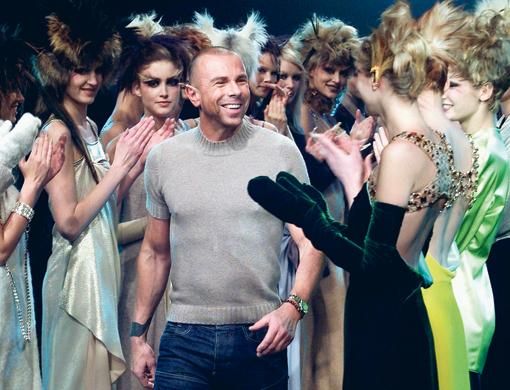I have to admit it. I was shocked when Thierry Mugler walked in an hour or so late for our meeting. The wait itself was no surprise: during his peak years as a fashion designer he was famed for starting his shows late, and he once made a journalist wait two days for an interview.
No, what shocked me about Mugler was his appearance. Not at all what I was expecting from a man entering his 60s. He's huge. Massive.
Since making his exit from fashion at the end of the 1990s, it turns out that Mugler has got into bodybuilding in a serious way, working out and stretching for two or three hours a day.
This impressive physique coupled with his tattoo would be quite intimidating without his gruff good humour and eyes that sparkle with mischief and life.
Although Mugler took his last bow on the catwalk after his July 2000 couture show and the fashion line bearing his name became unviable and was closed down completely three years later, his influence has never been stronger.
From cyber-chic metallic leggings and body-con dresses to his exaggerated, hourglass tailoring, suddenly his looks are everywhere.
After some of his classic pieces were shown in the Superheroes exhibition at New York's Metropolitan Museum last year, Beyoncé Knowles picked up on the trend and wore a vintage Mugler bustier fashioned out of a Harley motorcycle in some of the photographs for her album I Am Sasha Fierce. More than that, the singer asked him to create 58 new stage costumes for her world tour.
"She is an extremely talented and polished performer. She dances incredibly well, she acts, she sings - she's a complete artist.
"I was very touched that she asked me, because she could have asked younger people. But she recognised that I was pretty much at the origin of this moment now about superheroes, the structured silhouette and the extreme silhouette, and she wanted that."
For those who remember his spectacular, theatrical catwalk shows, it will be no surprise that Mugler also ended up directing sections of Beyoncé's live show. "I never considered myself a fashion designer," he explains. "My stuff was very much related to music - that was very important for me. So my shows expressed a lot of visuals, music and stuff - and then the fashion."
Mugler was born in Strasbourg in 1948 to a comfortably middle-class family: his father was a doctor, his mother very stylish, customising her own clothes and having one-off hats created to her own designs. Nonetheless, he describes his childhood as deeply unhappy. "I had a very strange sort of family," he says cryptically. "Very extreme."
It was his primary school teacher who suggested the ballet as an outlet. His mother, who would constantly complain that her son was "impossible", finally took him to a dance school out of desperation when he was nine. It was a liberation, he says - "Big time!" - and it offered him a much-needed discipline, too. He threw himself into it completely. By the time he was 14 he had joined the corps de ballet at the Rhine National Opera and left home to share a room with another dancer.
In what little spare time he had, he would make clothes for himself or customise flea market finds. "It was all my fantasies," he laughs. "I had a medieval period, a Flash Gordon period, a superheroes period, a Renaissance period - but always very futuristic. I was David Bowie before David Bowie!"
When he was 20, he moved to Paris to find a contemporary dance company, but suddenly his clothes began to attract a different kind of attention. "I was used to weird remarks and reactions, but everybody was stopping me in the street and asking me about my clothes. 'Wow! Where did you buy that?'"
He made some drawings, which he sold to the hip boutiques. And overnight, he says, he became a fashion designer. "I'd always had this idea of directing, of producing things on stage, and this was a way of having some control and some power. And at that time fashion was very important. People were expressing themselves through that. And it was fun!"
For the next decade he travelled, made clothes and embraced hippie culture.
noir-influenced
By the 1960s he began freelancing for fashion companies all over Europe. Designing everything from children's knitwear to leatherwear, he learnt every aspect of the job before launching his own label in 1974. From the start he bucked the trend. When everyone else was doing flowery, floaty womenswear, he went for film noir-influenced tailored suits, trenchcoats and little black dresses - a more elegant, put-together Parisienne look.
"And I started inventing all these cuts - the body-conscious cut, where all the seams would follow the body."
His interest was always in modifying the human form: padding out the shoulders, cinching in the waist, cutting to exaggerate feminine curves. His clothes were never easy to wear, he admits. "It was constraining. But it would make you look good."
He started small but grew fast, and by the 1980s he was one of French fashion's biggest stars. His colourful, often outrageous clothes were influenced by insects and angels, by sci-fi and superheroes. His shows were lavish productions. "I always was involved in everything, from the heels to the lashes, the storyboard to the music and sound effects. It was done like a movie. We never did rehearsals. So I discovered the show at the same time that you discovered it!"
Then, in the early 1990s, everything changed. His flashy clothes had been perfect for the power-dressing 1980s but began to look camp and dated next to the understated minimalism championed by designers such as Helmut Lang and Miuccia Prada.
Meanwhile, the grunge and waif looks were coming through as an antidote to the previous decade's artifice and glamour.
"I totally understood the kids," he says of the grunge movement. 'It was a healthy reaction, and it was charming, very cute. But as soon as it became fashion, a product, the whole thing was wrecked. I think that's when I quit, actually."
With the labels shaping themselves into global brands, the industry became all about money and marketing, and for Mugler, the fun went out of it. "I can't work on one-size girls, and now they're all so skinny, all the same! You're working with models who are looking at their watch, and it didn't work for me. I wanted to have relationships with amazing people."
In 1992 he launched his first perfume, Angel, and Clarins, his partner in the fragrance, also bought a share in his fashion empire. By 1997 it had bought him out completely, and Mugler had become increasingly disengaged. He agrees with me when I say it seems he left it all behind mentally long before he left physically.
"I realised I was living in my own universe, with lots of assistants. I didn't have a cellphone, I didn't know how to use a computer. Everybody was doing everything for me. So I left and moved to New York. It was the end of an era."
Last year the designer Rosemary Rodriguez was brought in to revitalise the fashion line, and one of her first moves was a capsule collection updating some of his classic outfits.
He recently fitted out a luxury yacht and he is also working on an architectural project in Dubai, but his main focus is, inevitably, directing and staging theatrical shows.
He is now based in Paris again, saying he moved back to France for love. I ask if there's a special person in his life and suddenly, unexpectedly, he comes close to tears, saying that it all became rocky while he was away working on the Beyoncé project. "Yes. A very special one, but& It's quite a difficult moment for me now."
The kind of creative life he has led sometimes makes relationships difficult, he adds, when he has pulled himself back together. "Sometimes when you do all this, you're alone."
You suspect that Thierry Mugler has always followed his heart first and foremost. Which is, I think, why I found him so likeable.
We part with a hug, but first he answers a question: why he turned his back so completely on fashion. "I left when I did," he says, those lively eyes once more twinkling with humour, "because I didn't want to become a monster."













